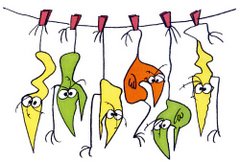Giant bird-eating spider struck in a backyard in Atherton, west of Cairns,
Australia.
- Spider is a Golden Orb Weaver
- Bird was a Chestnut-breasted Mannikin
Joel Shakespeare, head spider keeper at the Australian Reptile Park, said the spider
is a Golden Orb Weaver.
They usually feast on large insects and break down prey with their venom into a liquid
soup. It's unusual to see one eating a bird," he told 9msn.com.

Found on Telegraph, Oct 08/22, by Bonnie Malkin, Sidney... then redirected to 9msn.
_____
Thanks to Bonnie & co. from all PPG's spider admirers ! Yes, those who still come
to PPG to see once more the legendary camel spider !
Now, if you want to know more about this web weaver specialist...
go ahead > (Script : Damon Ramsey BSc.(Zool) Biologist Guide)
The 'Golden Orb Web Spiders', Nephila spp. are among the largest of the spiders
to build aerial webs.
They sit in the middle of their large 'orb' or circular shaped web usually with their
legs spread out and head pointing downwards.The abdomen is elongated and often
decorated with blacks, yellows and whites.
These spiders are referred to as a 'golden orb web' not because of the colours
sometime found on the spider (that can include golden yellows), but because, at the
right angle, the yellow silk of the web takes on a very delicate golden colour.
Unlike many spiders, they often leave their web up for some time, merely effecting
regular repairs. They can do this because their web of yellow silk is one of the strongest
amongst the spiders (Preston-Mafham and Preston-Mafham 1998).This is probably a
reflection of the large size of much of the prey they capture, for even the remains of
birds have been recorded in their webs (Raven 2000).
Most specimens of Golden Orb Web spiders observed are the females. This is because
the Nephila genus has the biggest size difference between females and males of any
spiders, with the tiny males sometimes being seen in the web.

(Smiling Golden Orb's portrait by Pagebao in Taiwan).
Before I leave you, I think it could be of some interest and pertinence to quote the
following sentence found somewhere in my searching about the Golden Orb :
"Mostly harmless, but they have inadvertently killed some 20 people over the years.
People died either from fright or tripping over as they tried to avoid or escape from
their rather strong webs."Pat the spider now !
___
[More posts about spiders...]
 was recently discovered
was recently discovered
 with large females and small males, which is manifested
with large females and small males, which is manifested





















